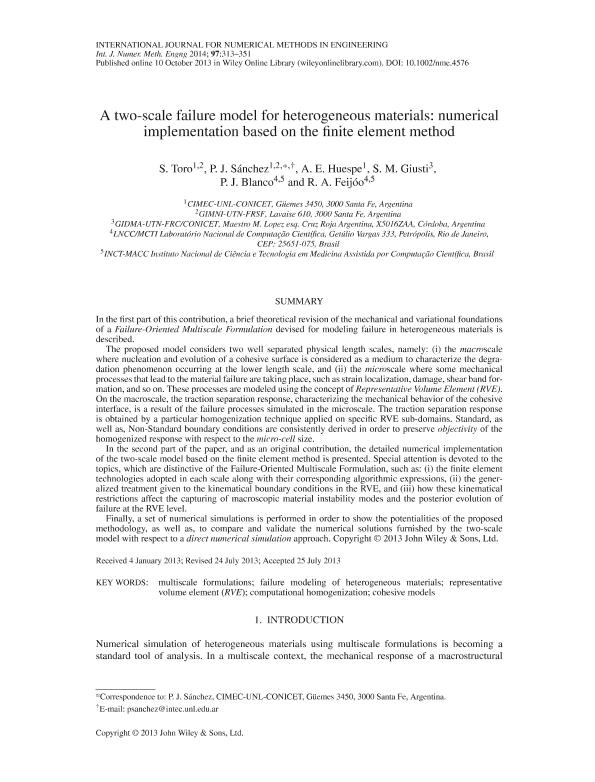Mostrar el registro sencillo del ítem
dc.contributor.author
Toro, Sebastian

dc.contributor.author
Sánchez, Pablo Javier

dc.contributor.author
Huespe, Alfredo Edmundo

dc.contributor.author
Giusti, Sebastian Miguel

dc.contributor.author
Blanco, Pablo Antonio

dc.contributor.author
Feijóo, Raúl Antonino

dc.date.available
2019-06-21T01:07:59Z
dc.date.issued
2014-02
dc.identifier.citation
Toro, Sebastian; Sánchez, Pablo Javier; Huespe, Alfredo Edmundo; Giusti, Sebastian Miguel; Blanco, Pablo Antonio; et al.; A two-scale failure model for heterogeneous materials: Numerical implementation based on the finite element method; John Wiley & Sons Ltd; International Journal for Numerical Methods in Engineering; 97; 5; 2-2014; 313-351
dc.identifier.issn
0029-5981
dc.identifier.uri
http://hdl.handle.net/11336/78607
dc.description.abstract
In the first part of this contribution, a brief theoretical revision of the mechanical and variational foundations of a Failure-Oriented Multiscale Formulation devised for modeling failure in heterogeneous materials is described. The proposed model considers two well separated physical length scales, namely: (i) the macroscale where nucleation and evolution of a cohesive surface is considered as a medium to characterize the degradation phenomenon occurring at the lower length scale, and (ii) the microscale where some mechanical processes that lead to the material failure are taking place, such as strain localization, damage, shear band formation, and so on. These processes are modeled using the concept of Representative Volume Element (RVE). On the macroscale, the traction separation response, characterizing the mechanical behavior of the cohesive interface, is a result of the failure processes simulated in the microscale. The traction separation response is obtained by a particular homogenization technique applied on specific RVE sub-domains. Standard, as well as, Non-Standard boundary conditions are consistently derived in order to preserve objectivity of the homogenized response with respect to the micro-cell size. In the second part of the paper, and as an original contribution, the detailed numerical implementation of the two-scale model based on the finite element method is presented. Special attention is devoted to the topics, which are distinctive of the Failure-Oriented Multiscale Formulation, such as: (i) the finite element technologies adopted in each scale along with their corresponding algorithmic expressions, (ii) the generalized treatment given to the kinematical boundary conditions in the RVE, and (iii) how these kinematical restrictions affect the capturing of macroscopic material instability modes and the posterior evolution of failure at the RVE level. Finally, a set of numerical simulations is performed in order to show the potentialities of the proposed methodology, as well as, to compare and validate the numerical solutions furnished by the two-scale model with respect to a direct numerical simulation approach.
dc.format
application/pdf
dc.language.iso
eng
dc.publisher
John Wiley & Sons Ltd

dc.rights
info:eu-repo/semantics/openAccess
dc.rights.uri
https://creativecommons.org/licenses/by-nc-sa/2.5/ar/
dc.subject
Cohesive Models
dc.subject
Computational Homogenization
dc.subject
Failure Modeling of Heterogeneous Materials
dc.subject
Multiscale Formulations
dc.subject
Representative Volume Element (Rve)
dc.title
A two-scale failure model for heterogeneous materials: Numerical implementation based on the finite element method
dc.type
info:eu-repo/semantics/article
dc.type
info:ar-repo/semantics/artículo
dc.type
info:eu-repo/semantics/publishedVersion
dc.date.updated
2019-06-19T16:53:08Z
dc.journal.volume
97
dc.journal.number
5
dc.journal.pagination
313-351
dc.journal.pais
Reino Unido

dc.journal.ciudad
Londres
dc.description.fil
Fil: Toro, Sebastian. Consejo Nacional de Investigaciones Científicas y Técnicas. Centro Científico Tecnológico Conicet - Santa Fe. Centro de Investigaciones en Métodos Computacionales. Universidad Nacional del Litoral. Centro de Investigaciones en Métodos Computacionales; Argentina
dc.description.fil
Fil: Sánchez, Pablo Javier. Consejo Nacional de Investigaciones Científicas y Técnicas. Centro Científico Tecnológico Conicet - Santa Fe. Centro de Investigaciones en Métodos Computacionales. Universidad Nacional del Litoral. Centro de Investigaciones en Métodos Computacionales; Argentina
dc.description.fil
Fil: Huespe, Alfredo Edmundo. Consejo Nacional de Investigaciones Científicas y Técnicas. Centro Científico Tecnológico Conicet - Santa Fe. Centro de Investigaciones en Métodos Computacionales. Universidad Nacional del Litoral. Centro de Investigaciones en Métodos Computacionales; Argentina
dc.description.fil
Fil: Giusti, Sebastian Miguel. Universidad Tecnológica Nacional. Facultad Regional Córdoba; Argentina
dc.description.fil
Fil: Blanco, Pablo Antonio. Laboratorio Nacional de Computacao Cientifica; Brasil
dc.description.fil
Fil: Feijóo, Raúl Antonino. Laboratorio Nacional de Computacao Cientifica; Brasil
dc.journal.title
International Journal for Numerical Methods in Engineering

dc.relation.alternativeid
info:eu-repo/semantics/altIdentifier/url/http://onlinelibrary.wiley.com/doi/10.1002/nme.4576/abstract
dc.relation.alternativeid
info:eu-repo/semantics/altIdentifier/doi/http://dx.doi.org/10.1002/nme.4576
Archivos asociados
